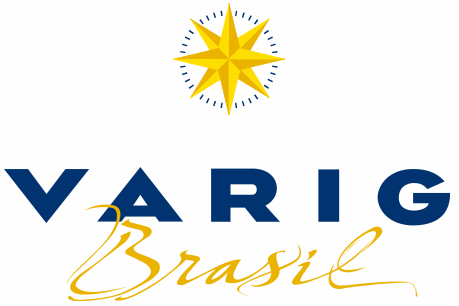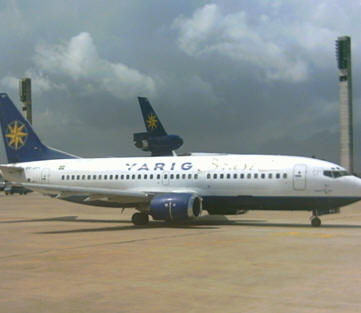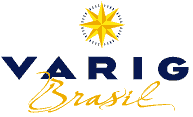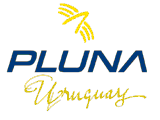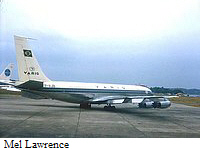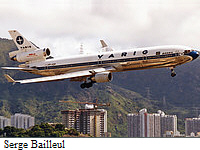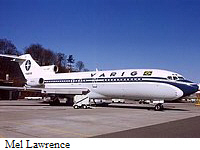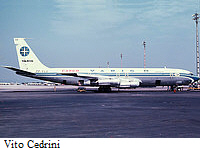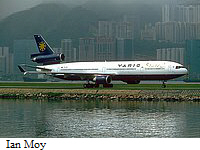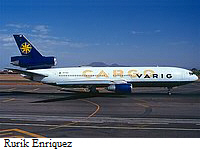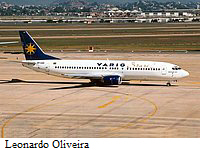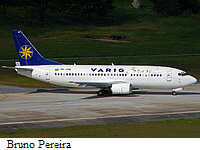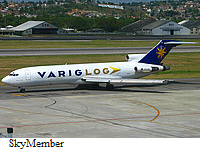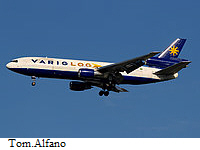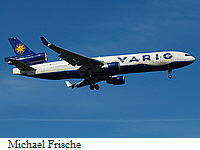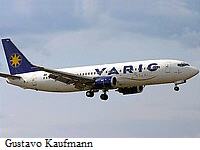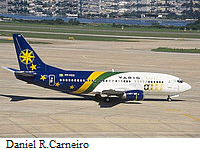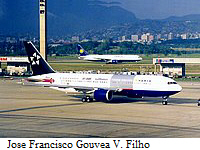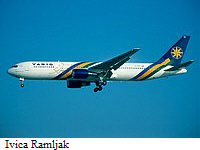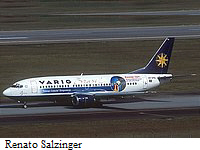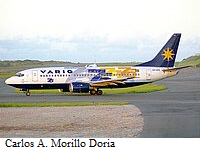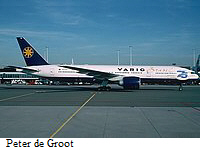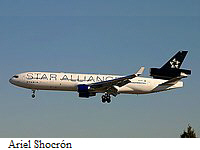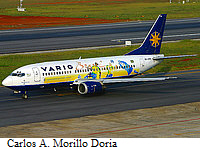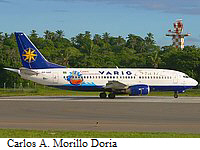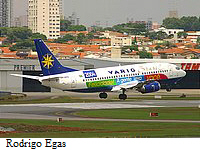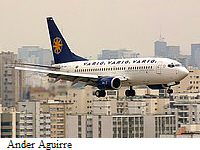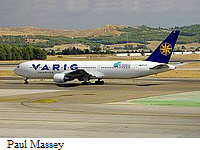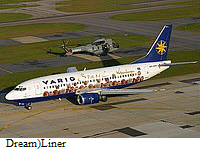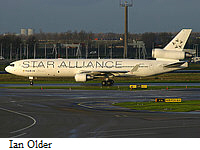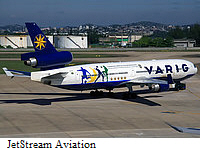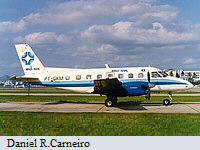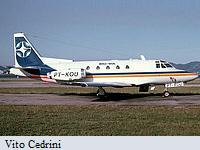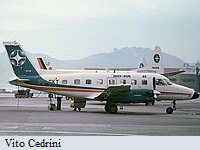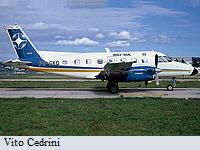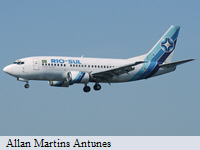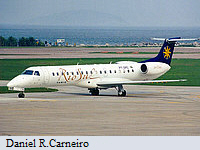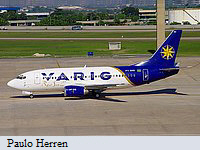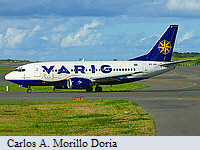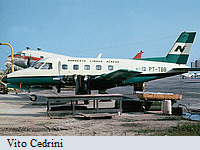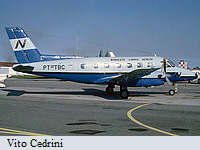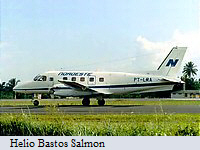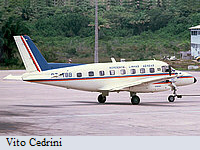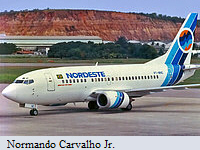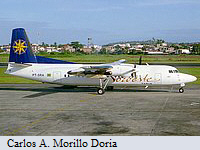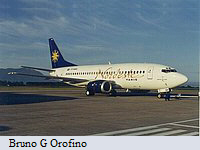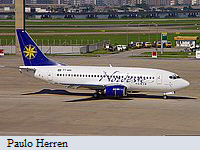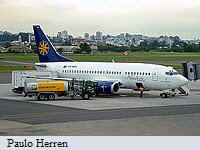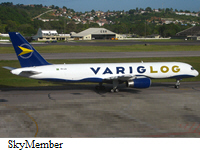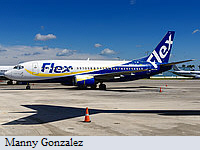On January 26, 1927 Condor Syndikat received authorization from the Brazilian government to operate in the country for one year. Thus on February 3, 1927 at 8 o'clock in the morning, the first Brazil’s commercial flight took off. The Dornier named "Atlântico" took off from Guaíba river to Rio Grande. The provisional name of airline was "Companhia Rio Grandense de Transportes Aéreos". The route linking Porto Alegre to Rio Grande with a stop in Pelotas lasted 2 hours and 20 minutes. This flight was known as "Linha da Lagoa” (Lake Line).
On May 7, 1927 the first Brazilian airline was finally born: Viação Aérea Rio Grandense, known as VARIG. Thus Condor Syndikat transferred the aircraft and the route to Varig in June 15, 1927. In December of that year Condor Syndikat founded another airline in Brazil: Syndicato Condor (later Cruzeiro do Sul).
In August 1927 Varig received its second aircraft, a Dornier Merkur named "Gaucho".
In 1929 the airline received two Klemm L25, but those aircrafts only carried bags and advertisements. However in 1930 Condor Syndikat left the company and so Varig had to return the "Gaucho" on June 25 and the "Atlântico" on July 2, remaining only with Klemm on the fleet. Thus Varig ask government help and incorporated two Junkers F-13. The first came on April 18, 1932 and with them Varig started flight to Livramento, Santa Cruz, Cruz Alta and Santana do Livramento.
In 1937 Varig received one Messerschmitt M20, the first plane with bathrooms on board, and the network was extended to Uruguaiana. In the same year Varig also received one Junkers JU-52, its biggest airplane, for 21 passengers. The aircraft was so big, that only took off if there were enough passengers.
In 1938 Varig was forced to cancel its first route, between Porto Alegre and Rio Grande, due low load factor. But the company continued to offer this route by train.
In 1941 the company received two Focke-Wulf FW-58 and one Fiat G-2.
In 1942 received one De Havilland Dragon Rapide and on August 5, 1942 began its first international route, from Porto Alegre to Montevideo. Even though Varig still small compared to Syndicato Condor and Panair do Brasil and also began to face problems due the Second World War. Most aircraft were from German origin and Brazil declared war against the Axis. Moreover Otto Ernst Meyer was German and decided to leave presidency to protect Varig in December 1942. Erik de Assis took his place, but died two weeks after the nomination. So Ruben Martin Berta become the new president. Ruben Berta was in the company since 1927 and as Otto Meyer was impassioned by Varig. The first thing that Berta did was standardize the fleet with American planes. The first was the Lockheed Electra I, which Varig began onboard service.
In 1945 Ruben Berta created Varig’s Employees Association. The idea was to protect and benefit Varig at the same time. The association would have 50% of the company and all Varig’s employees would be part of it. It would give a lot of benefits to employees, improving their life quality and consequently their production in the company. In October, 1945 the shareholders transferred 50% to the association. The association brought many benefits to Varig, but also was one of the responsible for its crisis fifty years later.
With the end of the Second World War, Varig received several DC-3. The first flight was on August 27, 1946, linking Porto Alegre, Rio de Janeiro and Sao Paulo. In 1948 came the Curtiss C-46 and Varig expanded its network to northeast. Varig also bought Aero Geral in May, 1952 and gained more DC-3/C-46.
In 1954 received the first Convair 240 that reduced the time of the flights due its speed. Varig operates thirteen units in all domestic routes and to Montevideo and Buenos Aires.
In 1953 Varig received permission to fly between Brazil and the United States, after Cruzeiro do Sul declined it. Thus Varig ordered three Lockheed Super G Constellation and inaugurated the route Buenos Aires - Montevideo - Porto Alegre - Sao Paulo - Rio de Janeiro - Bethlehem - Port of Spain - Trujilho - New York in July, 1955. The Constellation was configured with only 66 seats, for passengers comfort. Furthermore had eight bunk beds and female workers for the first time. On board the best was offered, Varig's cook was from Royal Russian Family and for many people Varig’s food was better than any restaurant in Brazil. Soon Varig began to be recognized as one of the best companies in the world and to compete with Pan Am. Real-Aerovias was also a competitor, but Real decided to attract passengers by low prices while Varig attract passengers by its service quality.
In September 1957 Varig ordered its first jet, three Boeing 707-400, and in October two Caravelle. But due problems in B707’s production, the Caravelle arrived first. Thus in September, 1959 Varig made the first flight with a jet aircraft in Brazil. Until Boeing 707 arrived, Caravelle made the route Rio de Janeiro - New York. With Caravelle the travel time was reduced from 25 to 14 hours.
In July 1959 Varig, Cruzeiro do Sul and Vasp coordinated their schedules and shared the revenue in Brazil’s busiest route: Sao Paulo (Congonhas) – Rio de Janeiro (Santos Dumont). This operation was called “Ponte Aérea” (Air Bridge).
The first Boeing 707-400 arrived on June 22, 1960, already bringing Varig’s passengers from New York. With the arrival of 707, Varig was the first airline to have nonstop flight between Rio de Janeiro and New York.
In August 1961 Varig became the biggest airline in domestic market after purchase Real-Aerovias-Nacional. After that fleet grew to more than one hundred aircrafts, but most of them were sold to pay the debt generated after the purchase. Beyond expand its domestic network, Varig also inherited routes to Lima, Bogota, Mexico, Los Angeles and Tokyo. But Varig was reluctantly to assume Real’s orders for Electra II and Convair 990. Electra II had a bad reputation in the United States due various accidents and Convair 990 didn’t have enough range for Varig’s long flights. But Electra II became Varig’s great asset, becoming the only aircraft to operate in Rio de Janeiro - Sao Paulo route for many years. The first arrived in 1962 and was used on domestic routes. For a time they also flight in “Voo da Amizade” (Friendship’s Flight) linking Rio de Janeiro to Lisbon with stops in Recife and Sal Island. In September 1962 Electra II began to flight in Rio - São Paulo route and still operating until January 1992.
In February 1965 the Brazilian military government declared Panair’s bankruptcy and its international routes and two DC-8-33 were tranfered to Varig. It was clear that Panair’s end had already been planned. On that same night Varig’s Boeing 707 assumed all Panair’s routes, revealing that Varig had already prepared to operate those routes several days before. With the end of Panair, Varig was now the largest airline in Brazil and Latin America. The company had also ordered seventeen Boeing 707-300 to cover its new international routes and increase frequencies. Varig also become one of the few airlines in the world to operate simultaneously the DC-8, Boeing 707 and Convair 990. Until 1968, Varig started flights to Lisbon, Madrid, Paris, London, Rome, Zurich, Copenhagen, Tokyo and Beirut.
In December 1966 Ruben Beta died at his desk and Varig’s Employees Association was renamed to Ruben Berta Foundation. In his place assumed Erik Chapman, a former Panair’s employee.
On August 21, 1970 Varig started to flight to Africa with Rio de Janeiro - Luanda - Johannesburg route. Also in 1970, the company received HS-748 also known as "Avro", which replaced DC-3. Varig also received it first Boeing 727 in 1970.
In December 1972 Varig chose Douglas DC-10-30 as its new intercontinental aircraft (against Boeing 747) because it was smaller and more economical.
In February 1974 the airline ordered some Boeing 737-200 and the first arrived in October of that same year. Varig’s first DC-10 arrived in May 1974 and began scheduled services in July to New York and Europe. The DC-10-30 was the first wide-body aircraft of Brazil and the most modern at that time.
In 1975 Cruzeiro do Sul was not doing well and negotiated its sale to Vasp. But in May of that year, Cruzeiro was bought by Varig. After this purchase Varig become the only Brazilian airline to have international flights and held the monopoly until 90s. Varig kept Cruzeiro brand until 1993 and used it to test new products.
In 1976 the Brazilian government decided forced the creation of regional airlines for increase the number of cities served by commercial flights. Varig and Top Taxi Aéreo created Rio Sul airlines, responsible for serving the south region, Rio de Janeiro and part of Sao Paulo and Espirito Santo Sate. During the 70s Varig experienced a super growth, becoming the largest private company in Brazil and dominating 50% of domestic market and 100% of international market. With a prominent position, the manufacturers wanted that the largest Latin America airline operate its aircraft, as Concorde and Airbus A300. Concorde did not come, but Airbus does. In April 1979 Varig orders two Airbus A300B4 and in June 1980 the first Airbus arrived. However A300 operated first for Cruzeiro on international routes to South America. Airbus aircraft was successful, quiet and comfortable, thus Varig ordered more two. In June 1981 the A300B4 arrived in Brazil and this time with Varig’s colors. Varig’s A300 operated in Sao Paulo – Santiago route and were the biggest aircraft to operate at Congonhas airport.
In January 1981 Varig ordered three Boeing 747-200. The airline was interested in this aircraft since 70s, but 747 was too big for Varig’s demand. Varig's 747-200B was half passenger and half cargo ("Combi"), more suitable for Varig's routes. The 747 debuted in the company on February 12, 1981, first in Rio de Janeiro - New York route, competing directly Pan Am’s Boeing 747-100 and then in Rio de Janeiro - Paris - Frankfurt route. In 1985 Varig ordered two 747-300 Combi, that arrived in December 1985 and replaced DC-10-30 in Rio de Janeiro - Los Angeles – Tokyo route. In 1988 Varig received more three Boeing 747-300, but this time "full-pax".
In March 1987 Varig received six Boeing 767-200ER to replace A300. The 767 were negotiated at very low prices because Boeing wanted that Varig ceased operate with Airbus aircraft. Varig was the first airline in the world to operate with a Boeing 767 with General Electric engines.
In 1988 the company received four Boeing 767-300ER and the first Boeing 737-300, which became the work-horse for domestic flights and replaced Electra II.
In 1989 Varig inaugurated Guarulhos International airport with the Boeing 747-200 in the new Sao Paulo – New York route.
In early 90s Varig started flights to Chicago, Orlando, Washington, Atlanta, Porto and Barcelona. But that decade was also the beginning of Varig's end.
In 1990 Varig loses the monopoly on international routes after Transbrasil and Vasp begin international flights, increasing competition and decreasing Varig’s profits.
In November 1991 Varig was one of the first airlines in the world to operate the new McDonnell Douglas MD-11. Varig’s MD-11 first route was Sao Paulo - Rio de Janeiro - Paris - Amsterdam. In December of that same year Varig also received its first Boeing 747-400, which operated on Sao Paulo – Rome route. With the Boeing 747-400 Varig inaugurated Rio de Janeiro - Sao Paulo - Johannesburg - Bangkok - Hong Kong route in 1993. But the 747-400 were negotiated in the Japanese currency and after a great appreciation of yen, even with 100% of load factor the 747-400 had loss. Moreover the competition in the international market was growing: previously only Varig and Pan Am flew between Brazil and the USA and in less than one year these two airlines began to compete with Vasp, Transbrasil, Eastern, American Airlines, United, Tower Air, Delta and Continental! Before the aircraft were full and the tariffs were high, but now the aircraft were empty and the tariffs were less than half. Beyond those significant changes in the international market, Varig also began to worry about a regional airline that was fastly growing with Fokker 100 aircraft: Tam. Varig’s subsidiary Rio Sul was still using propeller aircraft while Tam was already using jets.
In 1994 Varig cancelled routes to China, Tailand and Africa and returned all Boeing 747-400.
In 1995 Ruben Berta Foundation fired Varig’s president for the first time. Besides Ruben Berta Foundation also contributed to Varig’s crisis. The foundation had more than 80% of Varig and was totally against against dismissal of employees and was interfering more and more in the company. Between 2002 and 2005 Varig had nine presidents, all fired by Ruben Berta Foundation. With rising debts, Varig sold all its aircrafts and leased back (sale and lease back).
In 1995 Varig bought 49% of Pluna, which became part of the group. In the same year, Nordeste regional airlines was bought by Rio Sul and also became part of Varig group.
In the end of 1996 Varig introduced its new colors in a Boeing 747-300 and in November 1997 Varig was the first airline to join Star Alliance. But the debts continued to grow and Varig cut more routes and returned fourteen aircraft. The number of seats was reduced by 20% in international market and 17% in domestic market. Even so Varig ordered twenty two Boeing aircraft, including 737-700, 737-800 and 777-200.
In August 1998 Varig left "Ponte Aérea" (Air Bridge) and started to operate this route with its subsidiary Rio Sul. In the same year Varig was the first airline in Latin America to receive the Boeing 737-700. In 1999 all DC-10-30 and Boeing 747-300 were retired.
In January 2001 Gol begins to operate and forced the prices down, making Varig lose more money. In March Varig lost the lead in domestic market for Tam, but considering Varig, Rio Sul and Nordeste, Tam just beat Varig in 2003.
After September 11, 2001 the world faced an aviation crisis. While "modern" airlines (as Tam) rapidly reduced its international flights, the "traditional" airlines (as Varig) continued operate all international destinations and their planes flew empty, generating more losses. Thus Varig returned more than 22 aircraft and cut even more routes.
In November, 2001 Varig was the first Latin American airline to operate the Boeing 777 and Boeing 737-800. The first flight was on 15 November, on Rio de Janeiro - São Paulo - London - Copenhagen route. The 777 brought several innovations and now Varig could compete with Tam’s A330. The two 777 were baptized as "Otto Meyer" and "Ruben Berta" and were the two last new aircraft received by Varig. The Boeing 737-800 was also the first in Latin America with winglets and video monitors on board. However Varig’s order for twenty two aircraft was reduced to only five 737-700, two 737-800 and two 777-200 due financial crisis. Also in 2001 VEM (Varig Engineering and Maintenance) and Varig Log (cargo subsidiary) were launched.
In 2003 Varig began a code-share agreement with Tam, that would be the first step for a potential merge. Varig’s load factor increased and losses decreased, but on the other hand people who just flew Varig and suddenly boarded on Tam’s aircraft, discovered newer aircrafts and more entertainment on board. Varig and Tam merger failed after big resistance from Ruben Berta Foundation and Varig’s employees. “Submerged” in debts, Varig was forced to organize an emergency plan to restructure itself. In 2002 Rio Sul and Nordeste started to be absorbed by Varig and were fully integrated in 2004. In addiction more routes were canceled and more than ten aircraft were returned, including all Boeing 767-200. Varig also reactivate some Boeing 737-200.
In 2004 Varig received four Boeing 757. After Boeing announced the end of 757 production, its price was reduced. So Varig took four units and also more Boeing 777-200 and MD-11, all used. The goal was to replace as soon as possible all MD-11 for Boeing 777. Also in 2004 Varig announced the retirement of ERJ-145, arguing that ERJ’s leasing was more expensive than Boeing 737-500. Also in 2004 Varig returned to Johannesburg and Cape Town, but canceled the route months later.
In June 2005 Gol beat Varig in domestic market. In this year Varig's fleet was reduced to only sixty aircrafts, but Varig still had more than twice as many employees that Tam while Tam’s fleet had more than eighty aircrafts. The reason was that Ruben Berta Foundation did not allow dismissal, despite the fleet has shrunk to less than half. Almost penniless, the company sold Variglog to VOLO and VEM to Tap. There was also a speculation for a possible merge with Tap, but did not occurred. Without money to pay leasing, several planes were seized at foreign airports.
In 2006, due World Cup, Varig returned to Munich. In accordance with Tap, Varig ceases flights to Lisbon, leaving the market between Brazil and Portugal exclusively for Tap. In January Varig also stopped flying to Japan. In June Varig collapsed, almost whole fleet were grounded. On June 21, 2006 Varig cancelled all flights to Milan, Madrid, Munich, Paris, Los Angeles, New York, Mexico, Montevideo, Asuncion and Bogota. The airline remained flights to Buenos Aires, Caracas, Aruba, Santa Cruz de La Sierra, Miami, Copenhagen, Frankfurt and London. Several passengers were stranded at airports in Europe and the United States because no airline accepted Varig’s tickets. In July the company was divided into two: the "old Varig" got all debt and "new Varig" got the routes and aircrafts. There was made an auction and there were rumors of a possible purchase by Air Canada or Lan, but it was purchased by VOLO Brasil, the same that bought VarigLog. “New Varig” or VRG Linhas Aereas continued to operate with the old Varig CHETA until December. On December 14 2006, VRG Linhas Aereas gained its own CHETA and "Varig – Viação Aérea Rio Grandense" stopped flying officially after nearly eighty years.
|
Logos:
Group Logos: |
Founded: May, 1927
Ceassed: 2006
Hubs: Guarulhos, Congonhas, Galeão, Santos Dumont, Salgado Filho
Headquarters:
Porto Alegre
Code:
VRG / RG
Historical
Fleet:
Airbus A300-200, Boeing 707-300, Boeing
707-400, Boeing 727-100, Boeing 727-200, Boeing 737-200, Boeing
737-300, Boeing 737-400, Boeing 737-500, Boeing 737-700, Boeing
737-800, Boeing 747-200, Boeing 747-300, Boeing 747-400, Boeing
757-200, Boeing 767-200, Boeing 767-300, Boeing 777-200, Caravelle,
Convair 240, Convair 440, Convair 990A, Curtiss C-46, Douglas C-47,
Douglas C-53, Douglas DC-3, Douglas DC-6, Douglas DC-8-33, Douglas
DC-10-30, McDonnell Douglas MD-11, De Havilland Dragon Rapid,
Dornier Do J Wal, Dornier Merkur, Embraer ERJ-145, Fiat G2, HS-748,
Junkers A50, Junkers F-13, Junkers J-52, Klemm L25, Lockheed Electra
I, Lockheed Electra II, Lockheed Super G Constellation,
Messerschmitt M20, Messerschmitt BF108, Nordwyn UC641.
Destinations (domestic):
about 53
Destinations (international): about 23
South America and Caribbean: Montevideu, Punta Del Este,
Buenos Aires, Córdoba, Mendonza, Rosário, Santiago, Assuncion, Santa
Cruz de La Sierra, La Paz, Lima, Quito, Guayquil, Bogota, Caracas,
Paramaribo, Cayenne, Georgetown, Aruba, Port of Spain, Bridgetown,
Trujillo, Panama, San José.
North America: Mexico City, Cancun, Miami, Orlando, Atlanta,
Chicago, Los Angeles, San Francisco, New York, Montreal, Toronto.
Europe: Lisbon, Oporto, Madrid, Barcelona, Milan, Rome,
Paris, Zurich, Geneva, Frankfurt, Munich, Amsterdam, Copenhagem,
London.
Asia: Tokyo, Nagoya, Hong Kong, Bangkok, Beirut.
Africa: Johannesburg, Cape Town, Luanda, Maputo, Lagos,
Monróvia, Abidjan, Sal.

The Brazilian government noted that airlines were abandoning
regional routes due its low return. Thus was created the SITAR in
1976 that divided Brazil into five regions that would be served by
five new regional airlines: Rio Sul, Nordeste, Tam, Taba and Votec.
Rio Sul was founded on August 24, 1976 by Varig and Top Air Taxi and
was responsible for south region and Rio de Janeiro and Espírito
Santo State. The first flight occurred on September 9, 1976 on Porto Alegre - Rio Grande - Pelotas
route. Rio Sul's initial fleet
consisted of eight Piper Navajo, seven EMB-110 and some private
jets.
In May 1982 received its first Fokker F-27 and 1986 its first
EMB-120.
At this moment Rio Sul was also allowed to operate in main central
airports as Congonhas, Santos Dumont and Pampulha.
In 1990 received its first Fokker 50. But in the 90s Rio Sul started
to face a huge competitor. Tam began to expand rapidly with Fokker 100 jets
aircraft while Rio Sul operated turboprop aircraft only.
In 1992 Rio Sul was the first airline in Latin America to operate
the Boeing 737-500, with a very comfortable configuration (only
108 passengers) to compete directly with Tam’s Fokker.
In 1995 Rio Sul bought Nordeste and in August 1997 received its
first ERJ-145.
In 1998 presented its new visual identity, based on Varig’s pain
shame and initiated flights between Rio and Sao Paulo with Varig. In
2000 Rio Sul received the Boeing 737-300 that was used for Rio – Sao
Paulo flights.
In 2001 received its first Boeing 737-700 and intended to operate
only with jets B737 and ERJ-145, replacing all EMB-120 and Fokkers.
In 2002 Rio Sul had more than forty aircraft and a reasonable
financial situation, but Varig was in a gigantic financial crisis,
thus Rio Sul and Nordeste were absorbed by Varig. In 2004 both Rio
Sul and Nordeste were fully integrated, but its aircrafts remained
with its own paint shame until Varig's bankruptcy in June 2006.
Founded:
1976
Ceased: 2004
Hubs: Santos Dumont,
Congonhas, Salgado Filho
Headquarters:
Rio de Janeiro
Historical Fleet:
Piper Navajo, Boeing 737-300, Boeing 737-500, Boeing 737-700,
Embraer EMB-110, Embraer EMB-120, Embraer ERJ-145, Fokker F-27,
Fokker F-50, Lear Jet, Sabreliner 60
| Fleet/Year | 1985 | 1990 | 1995 | 2000 | 2004 |
|
RIO SUL |
|||||
|
EMB-110 |
7 | 5 | |||
|
EMB-120 |
8 | 10 | 8 | ||
|
ERJ-145 |
13 | 11 | |||
|
F-27 |
5 | 8 | |||
|
F50 |
9 | ||||
|
Boeing 737-300 |
2 | 4 | |||
| Boeing 737-500 | 6 | 16 | 6 | ||
| Boeing 737-700 | 2 | ||||
| TOTAL: | 12 | 21 | 25 | 39 | 23 |

In November 1975 the Brazilian government decided to create
SITAR that would originate five regional airlines to serve
five Brazil’s regions. Nordeste Linhas Aéreas was created by
Transbrasil and Bahia government and was responsible for
Piauí, Ceará, Rio Grande do Norte, Paraíba, Pernambuco,
Alagoas, Sergipe and Bahia. In addition the airline also
could fly to Maranhão, Minas Gerais and Espirito Santo, Rio
de Janeiro, Sao Paulo and Brasilia. Nordeste received its
first EMB-110 on June 8, 1976 and
shortly after Transbrasil would leave the partnership.
In November 1992 received the first
EMB-120.
On January 10, 1995 was bought by Rio Sul (part of Varig
group). So Nordeste’s fleet was renewed with
EMB-120, Fokker F-50 and Boeing
737-500 and the airlines a major expansion.
In 1999 the airline operated with three
ERJ-145, but still in Rio Sul’s
livery.
In 2000 received its first Boeing 737-300. But while
Nordeste was expanding, Varig was in a financial crisis. In
September 2002 Nordeste operations were absorbed by Varig in
an attempt to improve its financial health.
In 2003 Nordeste was fully absorbed by Varig, but some
aircrafts still with Nordeste’s livery until Varig's
bankruptcy in 2006.
In June 2006 Varig was divided into two companies; "new
Varig" and "old Varig". The “old” Varig adopted
Nordeste brand, but used Flex Linhas Aéreas as commercial
brand.
Founded:
1976
Ceased: 2004
Hubs: Deputado Luís Eduardo Magalhães
Headquarters:
Salvador
Historical Fleet:
Embraer EMB-110, EMB-120, Fokker F-27, F-50, Boeing 737-300,
737-500
| Fleet/Year | 1985 | 1990 | 1995 | 2000 | 2004 |
|
NORDESTE |
|||||
|
EMB-110 |
8 | 13 | 1 | ||
|
EMB-120 |
4 | 3 | |||
|
ERJ-145 |
3 | ||||
|
F50 |
2 | 6 | |||
|
Boeing 737-300 |
2 | ||||
| Boeing 737-500 | 1 | 3 | 4 | ||
| TOTAL: | 8 | 13 | 8 | 15 | 6 |
![]()
Air cargo transportation in Brazil began when Varig was created in
May 1927. In 1944 Varig started the first cargo flight between Porto
Alegre and Pelotas with Junkers F-13 and L10 Electra. On January 27,
1948 Varig received its first total freighter aircraft, a Douglas
C-47. The first jet freighter was Varig’s Boeing 707 that were
converted for cargo transport, after were replaced by DC-10.
In 1975 Varig received its first Boeing 727-100F that with Boeing
707 were the first to have “Varig Cargo” paint shame.
In 1986 Varig received its first wide-body freighter, the DC-10-30F
and 1993 Varig Cargo was officially created as Varig’s cargo
subsidiary.
In October of 2000 was founded an independent cargo subsidiary;
Varig Log (Varig Logistics) with four B727-100F, four B727-200F and
three DC-10-30F. The company already born with a global network and
hubs in São Paulo, Rio de Janeiro, Manaus, Porto Alegre, Frankfurt,
Miami and New York.
In 2005 was the first airline in Latin America to operate MD-11F.
But in 2006, due Varig’s financial crisis, VarigLog was sold to VOLO
Brasil. The company received new investments and incorporated Boeing
757-200F, Cessna 208 and Boeing 737-400F. However Varig Log never
recover itself from Varig’s crisis and suspended all operations in
February 2012.
Founded:
2000
Ceased: 2012
Hubs: Guarulhos
Headquarters:
São Paulo
Historical Fleet:
Boeing 727-100F, 727-200F, 737-400F, 757-200F, Douglas DC-10-30F,
MD-11F, Cessna 208
| Fleet/Year | 2001 | 2003 | 2006 | 2009 | 2012 |
|
VARIG LOG |
|||||
|
Boeing 727-100F |
5 | 4 | 4 | ||
|
Boeing 727-200F |
2 | 4 | 4 | 3 | 3 |
|
Boeing 737-400F |
2 | ||||
|
Boeing 757-200F |
2 | 3 | |||
|
DC-10-30F |
3 | 3 | 3 | ||
|
MD-11F |
2 | ||||
| TOTAL: | 10 | 11 | 13 | 5 | 8 |
![]()
In June 2006 Varig was divided into two companies: "new" Varig that
becames VRG Linhas Aéreas and "old" Varig that used the name "Nordeste
Linhas Aéreas". Then Nordeste Linhas Aéreas used Flex Linhas Aéreas
brand to start operations again. Flex initiated operations in March 2007
with one Boeing 737-300 and charter flights. But the airline failed and
ceased in a short time.
Founded:
1927 as Varig
Ceased: 2010
Historical Fleet:
Boeing 737-300
Updated 2012


